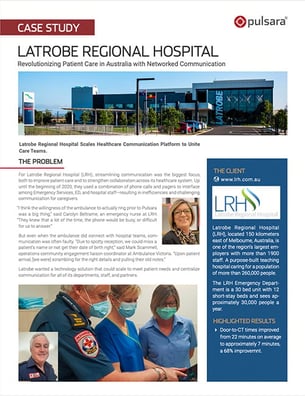But you don't even tell us the only outcome desired in stroke. 100% recovery! How many got that result? No measurement of that you all need to be fired. My God, the massive incompetence in stroke is appalling. Hope you are OK with that when YOU become the 1 in 4 per WHO that has a stroke?
Australia’s Latrobe Regional Hospital(Melbourne, Australia) Improves Door-to-CT Times by 68% with Pulsara (Case Study)
For Latrobe Regional Hospital (LRH) near Melbourne, Australia, streamlining communication has been a major area of focus, both to improve patient care and to strengthen collaboration across its healthcare system. Up until the beginning of 2020, they used a combination of phone calls and pagers to interface among Emergency Services, ED, and hospital staff—resulting in inefficiencies and challenging communication for caregivers.
“I think the willingness of the ambulance to actually ring prior to Pulsara was a big thing,” said Carolyn Beltrame, an Emergency Nurse at LRH. “They knew that a lot of the time, the phone would be busy, or difficult for us to answer.”

But even when the ambulance did connect with hospital teams, communication was often faulty. “Due to spotty reception, we could miss a patient’s name or not get their date of birth right,” said Mark Scammell, Operations Community Engagement Liaison Coordinator at Ambulance Victoria. “Upon patient arrival, [we were] scrambling for the right details and pulling their old notes.”
Latrobe wanted a technology solution that could scale to meet patient needs and centralize communication for all of its departments, staff, and partners.
Latrobe is the third hospital in the state of Victoria to implement a mobile communication platform called Pulsara. Made possible by grant funding, the hospital activated the technology across multiple entities in February 2020, including ambulance partners, cardiology, stroke, and mental health teams.
Pulsara connects people when seconds matter with a secure, unified patient channel—replacing multiple phone calls, radio reports, faxes, and pagers—and allowing care teams to communicate efficiently and effectively when treating patients.
Read the case study (or download it here) to learn how Latrobe Regional Hospital united their EMS and hospital teams on one communication channel, improving door-to-CT times by 68% — reducing them from an already impressive 22 minutes down to an average of just 7 minutes.
No comments:
Post a Comment